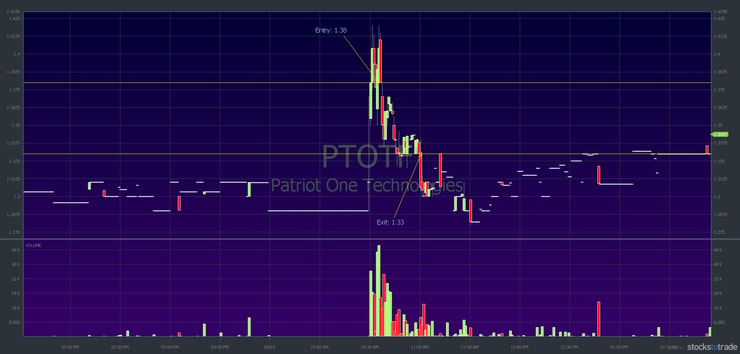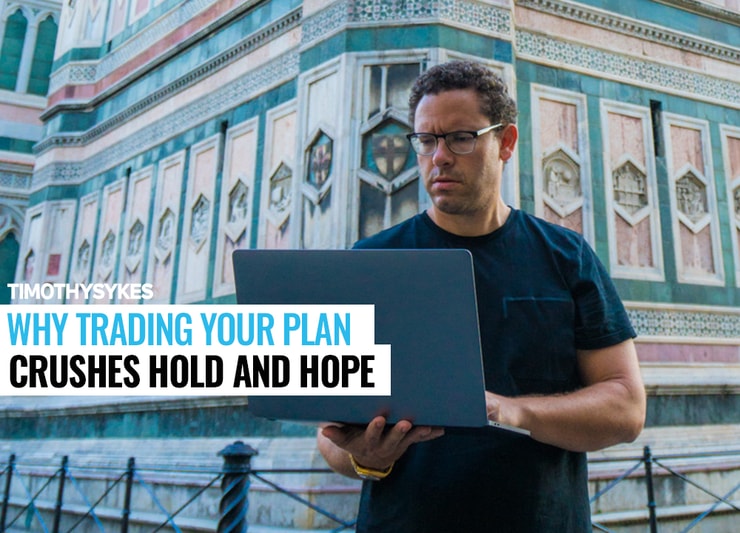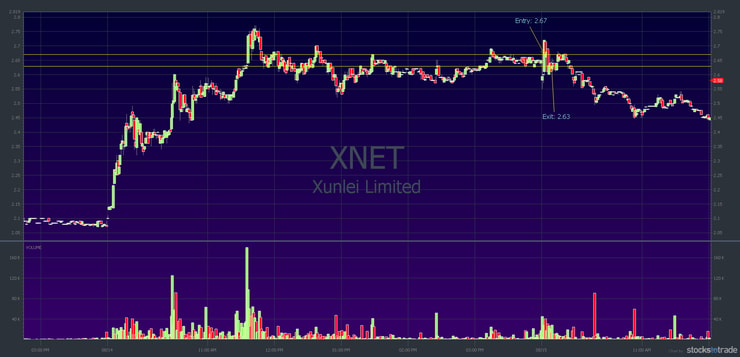It never ceases to amaze me how many traders fail to trade their plan. Instead, they rely on hold and hope as a strategy.
Using a trading plan is one of the most basic concepts every trader should learn. But too often, traders skip this all-important step. Maybe they join a program like the Trading Challenge, get alerts from the chat room, and then start to trade without any idea what to do when things go wrong.
Now, before I go any further, the Trading Challenge has a clearly defined syllabus. So nobody coming into the program should be doing what I explained above. But sometimes newbies don’t want to listen.
So, here you go…
Table of Contents
Any Moron Can Hold and Hope
Hold and hope is not a strategy. It’s your stubborn ego standing directly in your path and slapping you right in the face. Over and over. Because the longer you hold and hope, the more likely it brings a quick end to your penny stock trading career.
Sorry to be so blunt. But I have to get this off my chest. If you overstay your welcome in a bad trade, you’re pulling a hold and hope. And it’s one of the most reckless and stupid things you could ever do.
Any moron can hold and hope. One of the most important things I can do as a teacher is to help you to stay in the game. Forget about getting rich for a moment. I know if you’re reading this you want to get rich. Believe me, I want you to get rich.
But if you blow up your account because you fail to follow a plan and then fail to abide by Rule #1: cut losses quickly … you’re basically screwed in this game. You will lose. I don’t want that. Not for me or anyone.
What Happens When You Hold and Hope
When you hold and hope — rather than trade your plan — you risk ejecting yourself from the game. It’s like a baseball player attacking the umpire. He lets his rage get the best of him, and that’s that. Out of the game. The difference is, the baseball player can come back and play in the next game.
If you blow up your account because of your ego … that might be it.
A few things before I go into detail about trading your plan vs. hold and hope…
Yes, there are swing traders who hold positions for days and weeks. That’s cool. They do what they do, and I do what I do. Remember, the best swing traders still use risk management. So while it might seem like I’m advising you against their strategies, this is different.
Also, you’ve gotta remember that losses are part of the game. That’s why trading your plan is so important. A single trade won’t make you rich. But a single loss could destroy you…
The Danger of Hold and Hope: Long Side
If you’re trading a long setup, you could lose a high percentage of the money you risk.
It’s not likely you’ll lose all the money you risk. Not in a single trade. But you could lose it all in certain circumstances. For example, if a stock gets halted, tanks, and gets halted again. There are cases where the stock never trades again. Or maybe it trades so low it doesn’t matter.
Then there’s “the crow”. A crow gradually sinks lower and lower in price.
There’s also the risk of dilutive financing, reverse splits, bad news, reverse mergers…
… the list goes on.
In other words, there’s a lot beyond your control. For example, the 99.94% drop on XGTI (now VISL) I mentioned in this post about warrants. Hold and hope is not a strategy. It’s dangerous.
The Danger of Hold and Hope: Short Side
Right now, hold and hope is way more dangerous for shorts than longs. Especially for anyone trading with a small account. Why?
Check it out…
If you short sell, you have the potential to lose more than you risk on any trade. Remember, short-selling means your thesis is that the stock price will drop. You have to borrow shares to sell and then buy shares to cover when you’re ready to exit the position.
This is one big, nasty problem right now. There are so many shorts playing the game with no patience that we’re seeing short squeezes. (I love that it’s happening — it can create opportunity. Join the Trading Challenge to learn the ins-and-outs of playing short squeezes.)
What happens in a short squeeze? Shorts trying to get out of their position buy shares. When they buy on the ask or slightly higher to ensure their order gets filled … it can be a thing of terrible beauty.
As more and more shorts try to get out, the price squeezes higher and higher. Some recent short squeezes have spiked 100% … 200% … even up to 300%. And these things can move fast. The problem with margin account. Specifically for short selling, especially right now, is that you can’t always cut losses quickly even if that’s your plan.
You can get destroyed almost immediately. I keep hearing about big-time short-sellers getting crushed. Blown up accounts all over the place. I get messages and emails with short squeeze horror stories.
Why You Should Never Hold and Hope
Bottom line: you need to stay in the game. To stay in the game, you have to protect yourself. You have to have something left for the next trade. Other trades will come. If you miss one or you’re wrong, so be it. Move on to the next.
Haters come at me all the time saying, “Tim, you trade too conservatively. You should learn some new patterns and trade like the big boys…”
Or, “Tim, if you’d just held for another 30 minutes that small loss or small win would have been a big win.”
After two decades of trading, I’ve learned a few things about myself and the markets.
So here it is…
- I love profits more than I love being right. (Sometimes being right is painful because I have to watch as newbies blow up their accounts.)
- I’d rather protect my trading capital for the next trade than stroke my ego in the one I’m in.
- Learning the right lessons from small losses is better than learning the wrong lessons from big wins.
Why You Need to Enter Every Trade With a Plan

If you have a plan, it can help reduce trading stress. Especially if you stick to the plan.
That’s why I use the Sykes Sliding Scale. (After two decades of trading, I don’t go through every single indicator explained in my Trader Checklist guide, write down a score, and add it up. But I think you should for a while until evaluating a potential trade becomes second nature.)
Also, if you trade scared, trading isn’t scary. At the very least, it can be less scary because you know what you’ll do when the stock moves. And that goes for both wins and losses. If you plan for a 10%–20% gain and find yourself up 12% with resistance, guess what? You’ve met your goals and you can get out.
How to Trade a Red Day Green
I don’t usually take three trades in a day. It’s pretty rare. But I did on August 15, and it’s a great example of trading your plan vs. hold and hope. It’s also a great example of cutting losses quickly.
This simple rule has massive ramifications for your account, your wealth, your confidence, and your sanity. But you have to stick to your plan. Check it out…
I’ve been seeing a lot of speculative spikes lately — so I’ve tried more speculative trades. On August 15, my first two trades were speculative. I was wrong on both of them.
What happened? I lost $240 on Xunlei Limited (NASDAQ: XNET). Then I lost $485 on Patriot One Technologies (OTCQX: PTOTF).
Xunlei Limited (NASDAQ: XNET)
XNET was an earnings winner. Earnings winners have been spiking lately. I was going for the morning spike — but it failed. I bought on the thesis it would go red to green on the day. It didn’t.
(Red to green means the stock moves above the previous day’s closing price. Many traders see it as a psychological barrier, and when it happens, a stock can spike. It’s an example of a stock trading self-fulfilling prophecy.)
Take a look at the XNET chart showing my entry and exit:
As you can see, XNET held its gains from the previous day’s earnings spike. Again, some recent earnings winners have been spiking for multiple days. When it failed, I got out.
So I traded my plan, lost, and cut losses quickly. Next…
Patriot One Technologies (OTCQX: PTOTF)
PTOTF had what I thought was a big catalyst. They announced a partnership with Johnson Controls (NYSE: JCI). JCI is a $30 billion-plus company. The long-term PTOTF chart isn’t great. But when you have a little company partnering with a $30 billion company — that’s huge legitimacy.
Plus, there was a quote from someone at Johnson Controls in the press release. It’s usually a big deal when the big company is quoted in a partnership deal. You want to see the big company quoted.
(I go over this in several DVDs — including Pennystocking Part Deux.)
Take a look at the PTOTF chart below:

The stock was halted on the news. Usually, if a stock gets halted, the news is meaningful. So I thought it would spike. What happened? When it started trading, it had a tiny spike and then failed. When it failed, what did I do?
I traded my plan, lost, and cut losses quickly. Next…
Trade Your Plan So One Trade Won’t Break You
A lot of people, especially newbies, would get very frustrated…
“Ugh … two trades … two losses … I hate trading … this sucks.”
But you have to remember, I’ve had two losses in a row a lot. And if you go back through my history, you can see I don’t mind going for a red to green play. I don’t mind going for an earnings winner.
I don’t mind being wrong on a speculative spike.
What did I do on both of these trades? I went in with a plan and traded my plan. I followed rule #1 and cut losses quickly. I didn’t hold and hope. I didn’t say, “Oh, this news is huge, I’m gonna double up on my position and wait until the market says this matters.”
Small losses of a few cents per share are perfectly acceptable and within my risk.
Then what happened? This is where it gets fun…
Paradigm Convergence Technologies Corp Ltd (OTCPK: PCTL)
I won’t go into too much detail on this trade as I already wrote about it in this recent Millionaire Mentor Update. After you finish reading this post, go check it out. Again, I rarely trade three times in a day. But I saw the play and the potential was too good to miss. It was a nice little profit given my small size.
And guess what?
Because I cut my losses quickly on those first two stocks … I finished UP on the day. This is the beauty of trading your plan and cutting losses quickly.
If you cut losses quickly, you can be wrong.
Yes, it’s frustrating. Yes, it’s not fun. But keeping losses small can allow you to wait for the right trade and get back to green on the day, the week, or the month.
On the other hand, hold and hope can lead to disaster. Even if the stock turns around and you get a win, you learn the wrong lesson.
The End of Hold and Hope
I hope you now understand why hold and hope is a dangerous strategy. Learning to plan a trade and trade your plan is essential to your trading career. Feel free to ignore me, break my rules, and learn the hard way. Let me know how you do. I’ll be waiting.
Trading Challenge
You get everything I’ve learned over the last two decades as a member of the Trading Challenge. Membership includes thousands of video lessons, hundreds of archived webinars, and hundreds of hours of DVDs. Plus, you get new lessons and live webinars every week.
If you’re ready to work hard, study, and gain the necessary skills over time — apply today.
It’s not easy and not everyone is accepted into the Challenge. If you want in, you’ve gotta be willing to work your butt off. No lazy losers allowed. You in?
Are you a trader? Have you ever pulled a ‘hold and hope’ and watched your money disappear in a flash? Comment below and share your experience. New to trading? Comment below with “I will plan my trades and trade my plan.” I love to hear from all my readers!






Leave a reply